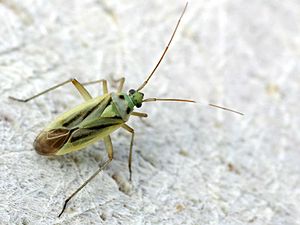Stenotus binotatus
| Stenotus binotatus | ||||||||||||
|---|---|---|---|---|---|---|---|---|---|---|---|---|

Stenotus binotatus |
||||||||||||
| Systematics | ||||||||||||
|
||||||||||||
| Scientific name | ||||||||||||
| Stenotus binotatus | ||||||||||||
| ( Fabricius , 1794) |
Stenotus binotatus is a species of bug from the family of soft bugs (Miridae).
features
The bugs are 5.8 to 7.4 millimeters long. They are relatively large and their variably colored body has more or less parallel edges. Males are usually yellow with extensive dark patterning on the pronotum and hemielytres . Females are greenish yellow with a much less pronounced dark pattern. Both sexes become darker with age and have a stronger basic color. In the males, the yellow turns to orange. The yellowish legs are long. Their rails ( tibia ) have black thorns. The last link of the antennae is much shorter than the third antennae . The wing veins of the hemielytric membrane are typically angled. Both the males and the females have fully developed (macroptere) wings.
Occurrence and habitat
The species is widespread in Europe and Asia, east to Siberia and Japan. It was introduced by humans in North America, Hawaii, New Zealand and Africa. In Central Europe the species occurs frequently everywhere. More humid, partially shaded and shady and less often open habitats are settled. The species also occurs on mown and fertilized grassland.
Way of life
Stenotus binotatus lives of grasses (Poaceae), such as Crest couch grass ( Agropyron ), timothy grass ( Phleum ), ball grass ( Dactylis ), alopecurus ( Alopecurus ), Molinia ( Molinia ) deschampsia ( Deschampsia ) holcus ( Holcus ) or Agrostis ( Agrostis ) without having preferences for specific species or genera. Mature nymphs and imagines suck preferably at the immature seed of the grasses, younger nymphs sucking before the development of the ears with the vegetative parts of the plants. The overwintering takes place as an egg. The nymphs appear from May, adult bugs from the beginning of June at the earliest, usually from July. In northern Germany you can only find adults from August. The females mostly lay their eggs from mid-July to mid-August. The adults die in September.
gallery
supporting documents
Individual evidence
- ↑ a b c d e Ekkehard Wachmann , Albert Melber, Jürgen Deckert: Bugs. Volume 2: Cimicomorpha: Microphysidae (lichen bugs), Miridae (soft bugs) (= The animal world of Germany and the adjacent parts of the sea according to their characteristics and their way of life . 75th part). Goecke & Evers, Keltern 2006, ISBN 3-931374-57-2 , p. 126 ff .
- ^ Stenotus binotatus. British Bugs, accessed July 4, 2015 .
- ↑ Frieder Sauer: Sauer's nature guide recognized bugs and cicadas from color photos . Fauna, Keltern 1996, ISBN 3-923010-12-5 , p. 137 .
literature
- Frieder Sauer: Sauer's nature guide recognized bugs and cicadas from color photos . Fauna, Keltern 1996, ISBN 3-923010-12-5 .
- Ekkehard Wachmann , Albert Melber, Jürgen Deckert: Bugs. Volume 2: Cimicomorpha: Microphysidae (lichen bugs), Miridae (soft bugs) (= The animal world of Germany and the adjacent parts of the sea according to their characteristics and their way of life . 75th part). Goecke & Evers, Keltern 2006, ISBN 3-931374-57-2 .
Web links
- Stenotus binotatus in Fauna Europaea. Retrieved July 4, 2015

